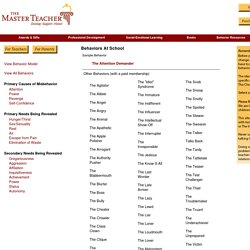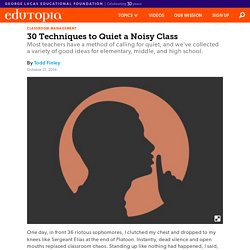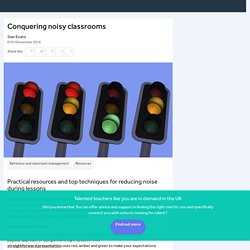

21 Phrases to Use in Dealing With Difficult Behaviors. The first priority in creating a positive classroom environment and limiting problem behaviors is to develop positive relationships.

That's absolutely essential. The second priority is to clearly establish expectations, for students and teachers. And that's a necessity also. Both teachers and students should know what to expect. Building relationships and communicating expectations must be tended to daily. But what happens when things go off the tracks a little? Set a Positive Tone 1. This is one of my favorite phrases. 2. Kids can't here this enough. 3. If a child feels you don't accept him or her, you aren't going to get their trust. 4. All of the problem-solving in working through an issue shouldn't come from the teacher. Address the Issue.
Teachervision. 4 Early-Year Keys for Effective Classroom Discipline. Nothing can undermine a classroom climate that's conducive to learning more quickly than a host of minor disruptive behaviors.

These behaviors alone may be no big deal, but collectively they steal instructional time and the positive energy that our students need to attain success. Although effectively managing student behavior is a multifaceted practice, there are four central things that you can -- and should -- do very early in the school year to set the proper tone. 1. Make your first words and actions confident, enthusiastic, and welcoming. Let your students know how glad you are to meet them or see them again. I am really pleased to have you all in this class. 2. Most teachers are good at letting students know routines, rules, and even consequences, but many neglect to share what might be the most important component that preserves everyone's dignity when rules are broken. 1. 2. 3.
Discipline Help: You Can Handle Them All. Awards & Gifts Professional Development Social-Emotional Learning Books Behavior Resources Blog View Behavior Model View All Behaviors Primary Causes of Misbehavior Attention Power Revenge Self-Confidence Primary Needs Being Revealed Hunger/Thirst Sex/Sexuality Rest Air Escape from Pain Elimination of Waste Secondary Needs Being Revealed Gregariousness Aggression Affiliation Inquisitiveness Achievement Power Status Autonomy Behaviors At School Sample Behavior The Attention Demander Other Behaviors (with a paid membership) The Agitator The Alibier The Angel The Angry The Animal The Apathetic The Apple Polisher The Arrogant The Authority Pusher The Blabbermouth.

NEWSLETTER1.6final 1qnot05. 30 Techniques to Quiet a Noisy Class. One day, in front 36 riotous sophomores, I clutched my chest and dropped to my knees like Sergeant Elias at the end of Platoon.

Instantly, dead silence and open mouths replaced classroom chaos. Standing up like nothing had happened, I said, “Thanks for your attention––let’s talk about love poems.” I never used that stunt again. After all, should a real emergency occur, it would be better if students call 911 rather than post my motionless body on YouTube. I’ve thought this through. Most teachers use silencing methods, such as flicking the lights; ringing a call bell—see Teacher Tipster’s charming video; raising two fingers; saying “Attention, class”; or using Harry Wong’s Give Me 5––a command for students to: Focus their eyes on the speaker, Be quiet, Be still, Empty their hands, and Listen. There’s also the “three fingers” version, which stands for stop, look, and listen. Below you’ll find a collections of lesser known techniques for all grade levels. How to respond to rude, disrespectful student attitudes - The Cornerstone For Teachers. I’ve written A LOT about behavior management: creating a strong, positive classroom culture and being proactive, as well as what to do about extreme student behaviors and how to undo your classroom management mistakes.

I’ve talked about how to avoid getting discouraged by these kinds of behaviors, and how to not give up on apathetic kids. But I haven’t addressed practical responses in the moment to student attitudes: How should you respond to the little things students do that are rude, disrespectful, or just annoying? What should you do for minor behaviors that don’t necessarily warrant some kind of consequence, but that you can’t let slide every time? Is there a way to keep kids from eye-rolling, teeth sucking, muttering under their breath, and so on?
Conquering noisy classrooms. Getting your class to settle down, and addressing constant low-level disruption, is part and parcel of delivering a successful lesson.

To support your existing classroom management strategies, check out this selection of posters, presentations and video tips that can be used with learners of all ages. Displays and charts To facilitate seamless transitions between and during activities, why not try the popular approach of using a traffic light system? This straightforward presentation uses red, amber and green to make your expectations clear to the whole class. Use this simple class sound meter to build pupils’ awareness of appropriate volume, ranging from silence to too loud. Alternatively, this colourful poster is ideal for controlling the amount of conversation that learners should be having, depending on what type of activity they are doing. Tips and techniques Quick links.